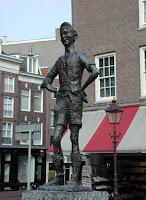On 9
December 2015, Nikolaj Kunsthal in Copenhagen opened an exhibition about Knud
Pedersen. The exhibition, curated by Johanne Løgstrup, is not exactly your standard gallery show: it only exists of videotaped interviews
with people who knew Pedersen and a list of projects on one wall that visitors
can refer to while listening to them. I participated by giving an interview and collecting the
material for the list. After all, I've known him since 2000 or 2001 and written about him in my Ph.D. and various other publications.
For the invitation, Nikolaj Kunsthal chose an image of Pedersen’s Copenhagen Museum of Modern Art. That is to say, the photograph does not actually show the museum, but the Danish National Bank, designed by Arne Jacobsen and built between 1965 and 1978. When the Copenhagen Museum of Modern Art opened in 1967, it found shelter in a small space in the basement of Nikolaj Church, where Pedersen had his Art Library, but later it became a conceptual museum. No building, no staff, no nothing – according to Pedersen the ideal venue for conceptual art. And since the museum had no actual physical existence, Pedersen thought, it might as well be the National Bank.
For the invitation, Nikolaj Kunsthal chose an image of Pedersen’s Copenhagen Museum of Modern Art. That is to say, the photograph does not actually show the museum, but the Danish National Bank, designed by Arne Jacobsen and built between 1965 and 1978. When the Copenhagen Museum of Modern Art opened in 1967, it found shelter in a small space in the basement of Nikolaj Church, where Pedersen had his Art Library, but later it became a conceptual museum. No building, no staff, no nothing – according to Pedersen the ideal venue for conceptual art. And since the museum had no actual physical existence, Pedersen thought, it might as well be the National Bank.
But it
would be wrong to say that the Museum had no existence whatsoever. Not only did
the Museum sponsor many art events, it also existed as a patent. Pedersen took
out a patent on the name and used it – more or less successfully – to file
lawsuits against other museums who tried to adopt names that resembled that of
the Museum. That the new museum in the suburb of Ishøj that the Municipality of
Copenhagen opened in 1994 is called Arken, and not the Copenhagen Museum of
Modern Art, for example, is due to Pedersen. If it did not have a physical existence, the
Museum at least had a legal one, and that is almost as solid in Western society
as we know it.
“The Museum
is Closed” is the title of the exhibition at Nikolaj Kunsthal. The museum is
closed, but the exhibition is open. The Copenhagen Museum of Modern Art only
exists as a concept, but it can act in the world thanks to its legal status
nevertheless. Is it accidental that Pedersen chose the National Bank as the
place to incarnate his Museum? After all, money has the same un/real character,
not really there but available for use nevertheless. Maybe there is more to
Pedersen’s choice than just a “why not…?”
See also Knud Pedersen Day, my somewhat offbeat attempt at an obituary for an extremely offbeat man.
See also Knud Pedersen Day, my somewhat offbeat attempt at an obituary for an extremely offbeat man.











